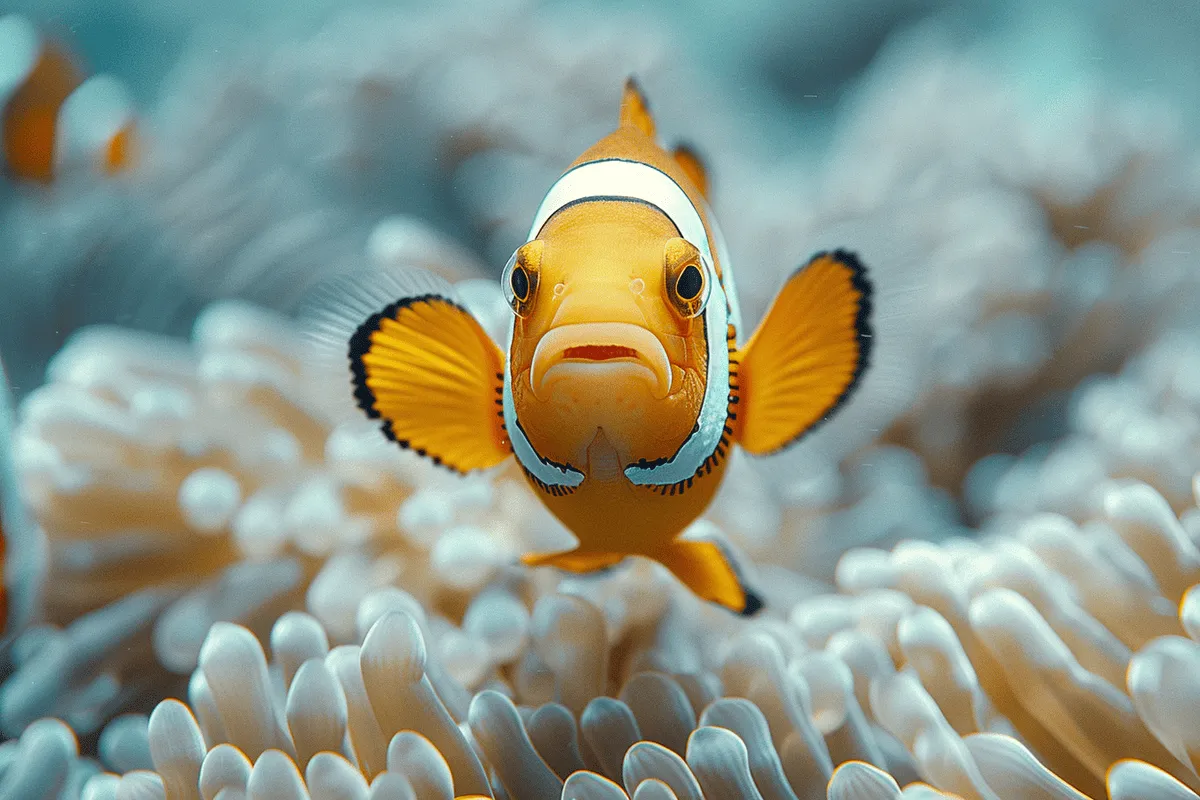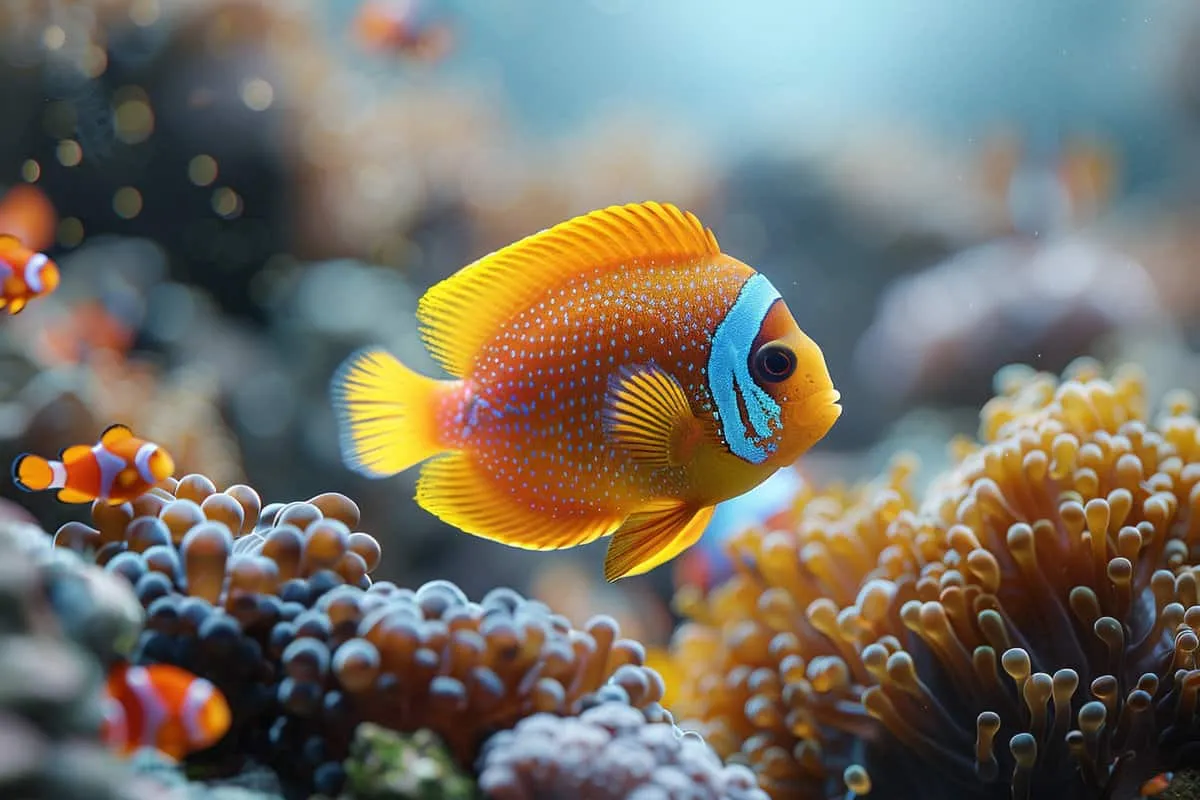10 Clownfish Facts (Surprising Insights)
Clownfish are more than just animated characters from a beloved movie; they’re fascinating creatures with unique behaviors and relationships.
Living among the dancing tentacles of sea anemones, these vibrant fish have developed an incredible mutual relationship that protects them from predators and provides their hosts with food scraps.
But there’s so much more to discover about these underwater marvels, from their surprising lifecycle to how they communicate within their aquatic homes.
Ready to uncover some mind-blowing clownfish facts? Scroll down as we reveal our top picks that will make you see these iconic reef inhabitants in a whole new light.
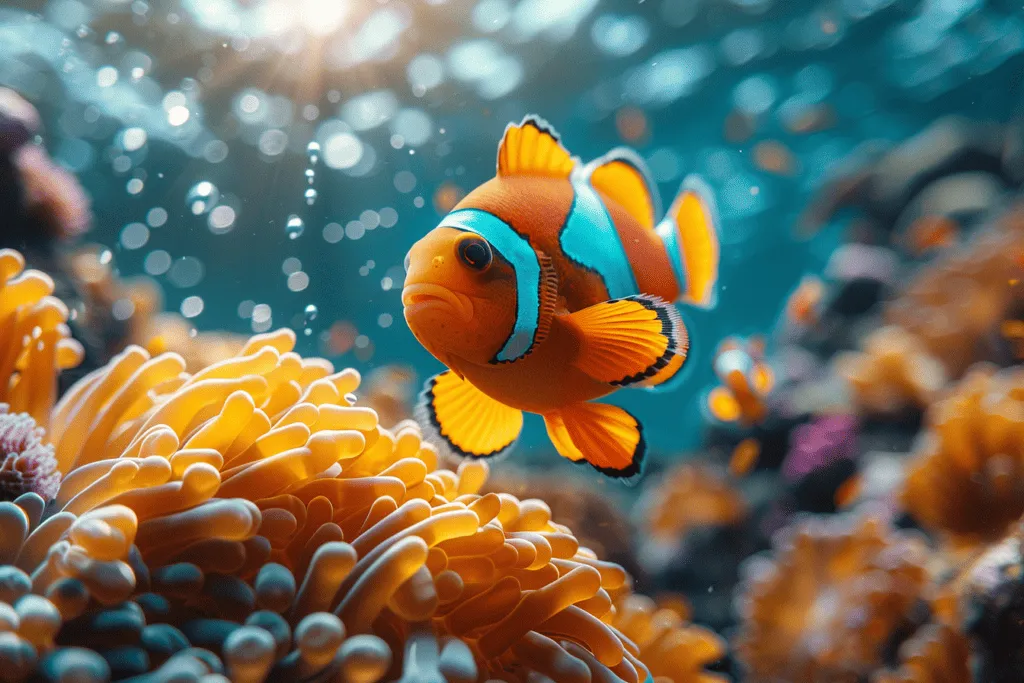
1. Symbiotic Relationship with Sea Anemones
Clownfish and sea anemones share a unique bond, living together in the ocean’s shallow waters. This partnership is known as a symbiotic relationship because both parties benefit from it.
The clownfish find safety among the venomous tentacles of sea anemones, which scare away potential predators.
But how do clownfish avoid getting stung by their host anemone?
It’s all about a special mucus coating on their skin. This mucus is different from what other fish have, making clownfish immune to the anemone’s sting.
In return for protection, clownfish play their part too. They feed on small invertebrates that could harm the sea anemone and also provide nutrients through their waste.
This helps in keeping the water around the anemone clean and rich with essential elements.
Moreover, there’s another interesting aspect of this relationship involving algae.
Clownfish help circulate water around the sea anemones, ensuring that sunlight reaches them.
Anemones need sunlight to keep their internal algae healthy; these algae produce oxygen through photosynthesis which benefits both partners.
2. Ability to Change Sex
In the fascinating world of clownfish, every member starts life as a male. This unique trait sets the stage for an extraordinary transformation that can occur under certain conditions.
These colorful fish have a remarkable system in place. There’s always a dominant pair within their group, consisting of a female and her mate. The rest remain male until needed.
The twist in their tale occurs when the female passes away.
In this event, the dominant male steps up, undergoing a complete change to become the new female of the group. This ensures there is never a void in their breeding pair structure.
This ability to switch sex from male to female is not just about changing roles but involves significant changes in their bodies too. The skin and internal reproductive organs transform, enabling them to take on their new role fully.
Such adaptability serves as an insurance policy for clownfish populations, ensuring they continue thriving even if females are lost. It’s nature’s way of keeping the cycle going without missing a beat.
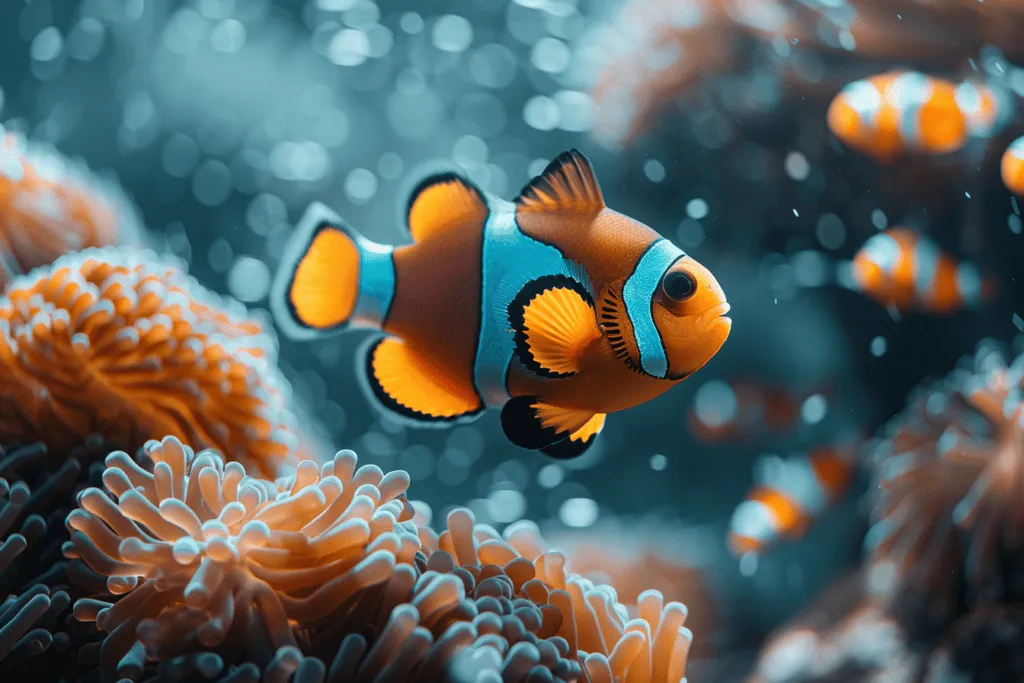
3. Vivid Colors Serve as a Warning
Clownfish are famous for their bright orange bodies, complemented by white bars or stripes. These colors do more than just make them stand out in the ocean. They serve as a warning to predators about their toxicity. It’s like nature’s way of saying, “Stay away!”
Each species of clownfish has its unique color pattern. This variety is not just for show; it plays a crucial role in their survival.
The distinct patterns help clownfish identify and attract mates within their own species.
The combination of bright orange, black, and white bands or stripes offers protection in several ways:
- Bright Orange Body: Easily visible among the coral reefs, signaling caution to potential threats.
- White Bars or Stripes: These markings can vary in number and placement but are essential for recognition among species.
- Black Edges: Some clownfish have black outlines around their white bands or on fins which may enhance the warning signal to predators.
Beyond visual warnings, clownfish also produce clicking noises that might contribute to deterring predators or communicating with each other.
4. Limited Home Range
Clownfish are fascinating creatures that stick close to home. They form a unique bond with their host anemone, which provides them both safety and food.
This relationship is so important that clownfish spend their entire lives within just a few square meters of their anemone home.
Why do they stay so close? The answer lies in the benefits the anemone offers.
It’s not just about protection from predators; the anemone also serves as a source of food for the clownfish.
In return, clownfish help keep the anemone clean and defend it against potential threats.
This limited home range is crucial for their survival. By staying within this small area, clownfish ensure they can quickly retreat to safety if threatened by predators outside their comfort zone.
Populations of clownfish are structured around these host anemones, with each group forming its own hierarchy or dominance chain. This structure helps maintain order within the population and ensures resources like food are distributed efficiently among group members.
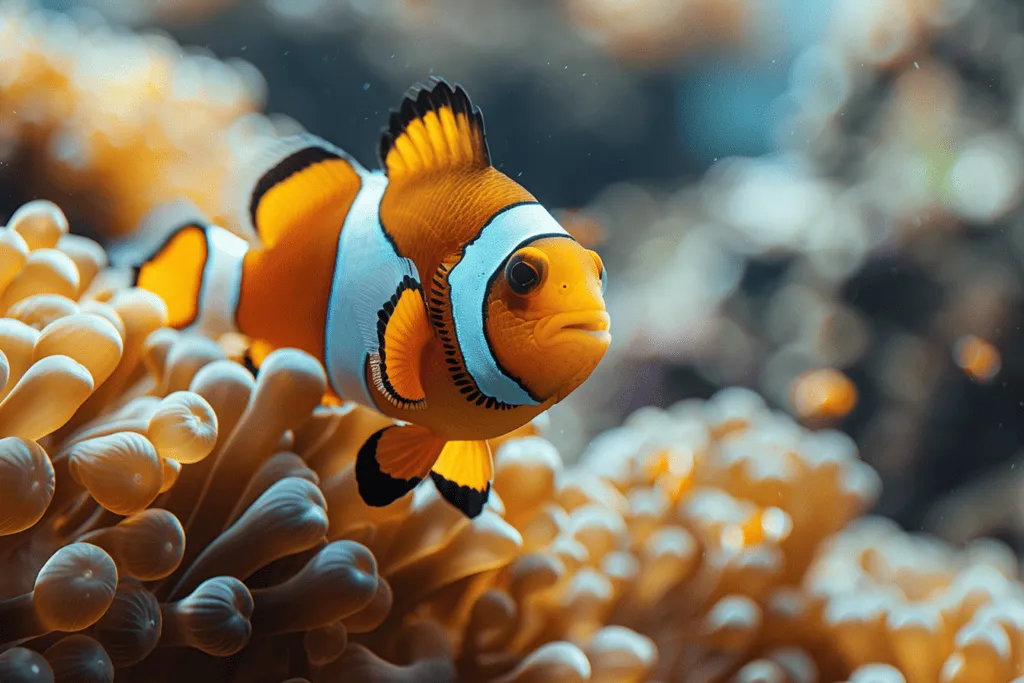
5. Omnivorous Diet
Clownfish have a varied diet that includes algae, plankton, and small crustaceans. This mix of food sources ensures they get all the nutrients they need to thrive.
Their feeding habits are quite interesting as they help clean their surrounding environment.
By munching on algae and food scraps left by predators, clownfish play a crucial role in keeping their homes tidy.
Moreover, these colorful fish contribute significantly to the health of their host anemone.
The leftovers from their meals serve as food for the anemone. In return, the anemone provides a safe place for clownfish to live and protection from predators.
This symbiotic relationship between clownfish and their host anemones showcases how interconnected marine life is.
Clownfish not only get shelter but also ensure their homes are well-fed and clean.
6. Breeding and Care of Eggs
Male clownfish are the homemakers of the sea. They carefully select and prepare nesting sites close to anemones, ensuring a safe environment for their future offspring.
This choice is crucial because anemones provide protection from predators with their stinging tentacles.
Once the female lays her eggs near these chosen sites, it’s up to the male clownfish to step into his next role: guardian.
He diligently guards the eggs against any potential threats. But his job doesn’t stop at just watching over them; he also has to make sure they receive enough oxygen.
To aerate the eggs, male clownfish fan them with their fins and even remove debris that might hinder air flow.
This constant care is vital for the survival of the eggs, which can range in number from a few dozen to hundreds depending on species and environmental conditions.
This breeding behavior highlights not only the complexity of marine life but also underscores how critical parental care is among clownfish for ensuring their young ones see through to hatching day successfully.
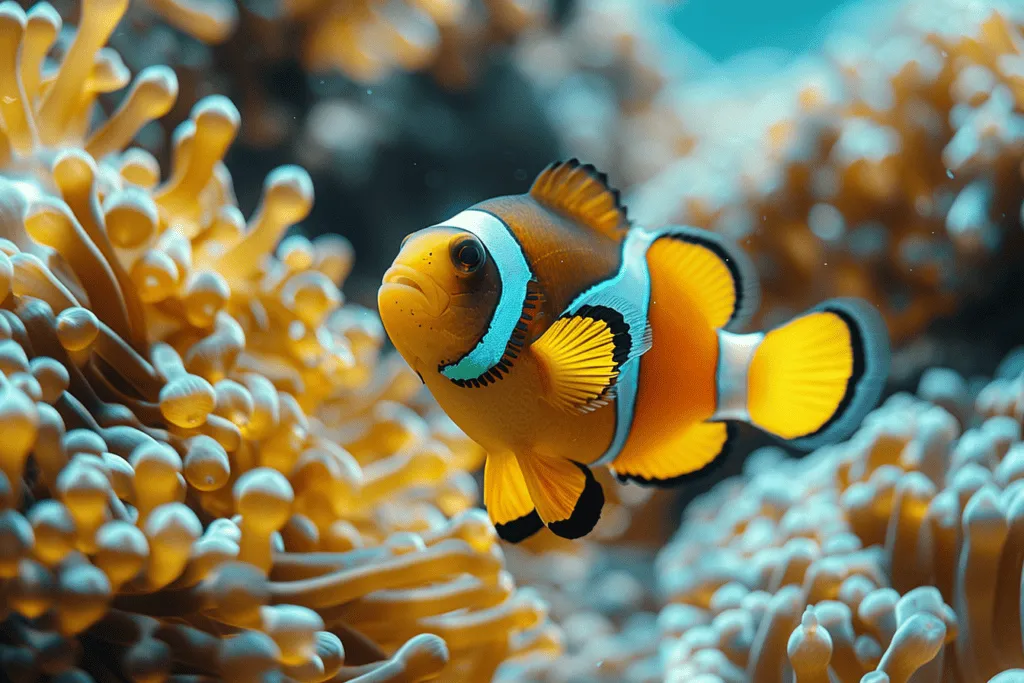
7. Importance in Coral Reef Ecosystems
Clownfish play a crucial role as bioindicators for reef health. This means they help scientists understand how healthy or unhealthy a reef is. When clownfish populations are thriving, it’s often a good sign that the reef is doing well too.
They’re also part of mutualistic relationships which support the diversity of life on reefs.
For example, clownfish live in and protect sea anemones, and in return, the anemones provide them with shelter from predators. This partnership benefits both parties and adds to the overall health of coral ecosystems.
Furthermore, their feeding habits contribute significantly to nutrient cycling within their habitats.
Clownfish feed on small zooplankton floating around in the water as well as algae and small crustaceans.
The leftovers from their meals become nutrients for other marine life forms, aiding in maintaining a balanced ecosystem.
8. Popularized by “Finding Nemo”
The movie “Finding Nemo” did more than just entertain kids and families around the world. It turned the spotlight on clownfish, sparking a wave of interest in marine life conservation.
After the film’s release, conversations about how pet trade impacts wild populations became more common.
People began to question if taking these colorful creatures from their natural habitats for home aquariums was ethical.
Moreover, “Finding Nemo” raised awareness about the importance of coral reef ecosystems.
These underwater environments are not just beautiful; they’re crucial for marine biodiversity.
The movie showed how delicate these ecosystems are and how vital it is to protect them.
Unfortunately, there was also a downside. The popularity of clownfish as pets surged, leading many to be taken from their natural habitats into captivity.
This trend highlighted the need for sustainable practices in pet trade industries.
9. Variations Across Species
With over 30 known species of clownfish, these colorful creatures display a stunning variety of colors and patterns.
Each species stands out with its unique look, ranging from vibrant oranges to deep blacks, often accented with white stripes or spots.
Not all clownfish live in the same type of environment. Some prefer specific types of anemones in particular ocean areas.
This specialized habitat preference ensures that each species adapts uniquely to its surroundings, contributing to the biodiversity within their ecosystems.
The social structure among clownfish species is fascinating and varies significantly.
Most groups are led by a dominant female, the largest member of the group.
If she dies, one of the males will change gender to become the new dominant female.
This hierarchy system is observed across different species but can vary in terms of group size and behavior dynamics.
- Interesting facts: The transformation from male to dominant female can take years.
- Species diversity: From solitary individuals to large groups cohabitating in harmony.
These differences highlight how adaptable and versatile clownfish are as animals within nature’s vast tapestry.
10. Threatened by Climate Change
Climate change is a big problem for clownfish. The rising sea temperatures are not good for coral reefs or the anemones that clownfish call home.
When the water gets too warm, these vital habitats can get sick or even die.
Another issue is ocean acidification. This happens when the ocean absorbs too much carbon dioxide from the air, making it more acidic.
This acidity can harm the calcium carbonate structures that many sea creatures, including those important to clownfish habitats, rely on to survive.
As their homes in the wild face these threats, clownfish populations start to drop. They have less space to live and fewer resources to share among themselves.
Over time, this could lead to fewer clownfish in our waters.
- Coral reefs and anemone health suffer as sea temperatures rise.
- Ocean acidification threatens calcium carbonate-based marine life.
- Habitat loss results in decreasing population numbers of clownfish.
These changes don’t just affect clownfish; they signal broader issues within marine ecosystems that require urgent attention.
Frequently Asked Questions
How do clownfish and sea anemones benefit from each other?
Clownfish and sea anemones are like best buds in the ocean. The clownfish gets a safe home away from predators, while the sea anemone snacks on leftovers from the clownfish’s meals. It’s a win-win!
Can all clownfish change their sex?
Yep, it’s pretty wild! Clownfish are born male but can switch to female if the top lady of their group swims off into the big blue yonder. Once they go female, there’s no turning back.
Why are clownfish so brightly colored?
Those vibrant colors aren’t just for show; they’re saying “back off!” to would-be predators. It’s nature’s way of telling others that messing with them might not end well because of their toxic roomies, the sea anemones.
Do clownfish travel far from home?
Not really; they’re homebodies. Clownfish stick close to their host sea anemone almost all the time. Think of them as having everything they need within arm’s reach – why venture further?
What do clownfish eat?
They’re not picky eaters at all – munching on both plants and meat makes them omnivores. From tiny zooplankton floating around to algae spa treatments for dessert, they’ve got varied tastes.
How do clownfish take care of their eggs?
Clown dads are super dedicated! They fan and guard their precious eggs until they hatch, making sure future generations get a fighting chance in the big blue world.
Why should we care about protecting coral reefs for clownfish?
Coral reefs are like bustling cities for marine life. They provide food and shelter to our colorful friends.

